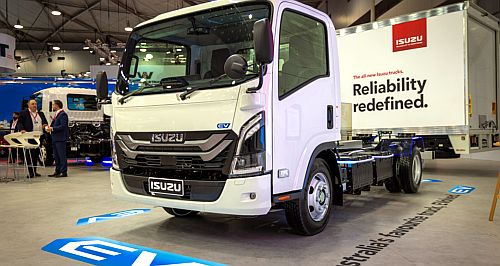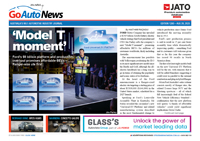Make / Model Search
News - TrucksTruck industry dismisses hybrids – except HinoHino stands alone as truck brands bypass hybrid tech in favour of BEVs, hydrogen19 May 2025 WITH one notable exception, Australia’s truck industry appears to have reached a consensus on bypassing hybrid technology and moving directly from diesel engines to battery electric (BEV) and hydrogen fuel cell (FCEV) alternatives, although development of hydrogen combustion and biofuels such as hydrotreated vegetable oil (HVO) continues.
Unlike the passenger car market, which is experiencing increased hybrid demand and plug-in hybrid popularity as growth in battery electric vehicle uptake slows, truck manufacturers are firmly focused on full electrification – with the notable exception of Hino, which continues to champion its hybrid electric technology.
However, charging infrastructure – including the supporting energy grid – and clarity on government policy were cited as ongoing roadblocks by several truck industry representatives at the recent Brisbane Truck Show (BTS).
Speaking with GoAuto at BTS, Daimler Truck Australia Pacific head of vehicle homologation, regulatory affairs and future mobility Romesh Rodrigo conceded that commercial BEV adoption was “really early days” and “not probably going at the rate that was projected” but that this was “probably in line with what we’ve seen in the passenger car domain”.
When asked about the potential for hybrid trucks, in the context of net zero goals Mr Rodrigo was dismissive: “What's the future for hybrid? To a certain extent, it's finite. It is a stop gap. Whereas electric, hydrogen (fuel cell), or hydrogen internal combustion, in theory, has legs.”
Standing between a Mercedes-Benz eActros heavy rigid BEV truck and the eEconic BEV garbage truck platform, Mr Rodrigo pointed out mechanical complexity as a key disadvantage of hybrid technology in commercial vehicles.
“While these have, you can argue, the potential for reduced mechanical complexity, they still require maintenance,” he said.
“And then with a hybrid, you have the added complexity of the internal combustion engine as well as the control system, so going forwards, what's the future for hybrid?
“We really need to back technologies that we see futures in. And when you look at hybrid, it's a really good stopgap but is that going to help achieve (net zero) goals while potentially consuming a lot of fossil fuel?”
This sentiment was echoed by Foton Mobility Distribution light vehicles general manager Bill Gillespie, who told GoAuto that feedback from major Foton fleet customer Woolworths was that “they aren’t interested in hybrid” because the technology still relies on an internal combustion engine, making it harder to achieve net zero than going all-in on electrification.
In terms of Woolworths’ last-mile fleet, Mr Gillespie said the grocery giant wants to “stop buying diesel”.
According to Mr Gillespie, Woolworths has set an ambitious goal to convert its entire 1200-vehicle last-mile fleet to electric by 2030, with 54 Foton T5 electric trucks to be delivered in the next two months and bringing the number of T5s supplied to Woolworths since July 2023 to around 120.
He said that so far the Woolworths fleet of Chinese-made T5s had covered a cumulative two million kilometres and that driver feedback had been positive, especially in terms of reduced fatigue.
Isuzu, which has hybrids in its Japanese domestic market, has so far elected to trial only battery electric versions of its N Series light trucks in Australia and is planning to expand the local trial fleet.
According to Isuzu representatives at BTS, Australia’s biggest-selling truck brand is working with its parent company to establish the difference in up-front cost and fuel consumption of the hybrids before determining if following up the N Series BEV trial with hybrids is likely to be worthwhile for customers.
They pointed out to GoAuto that the difference in price between ICE and BEV light trucks was far greater in percentage terms than that of equivalent ICE and BEV passenger cars but suggested that this was more convincingly offset by the total cost of ownership in terms of fuel and maintenance savings than hybrids.
Standing apart among truck brands is Hino, which continues to promote its hybrid technology – although the company did have a Dutro Z-EV electric light truck on its BTS stand, which is undergoing local trials, but Hino Australia president and CEO Richard Emery seemed cautious about its viability for this market.
“In just the same way as spent time interrogating that balance – cost, range and payload – for the 300 Series Hybrid Electric, we intend to undergo that process with the Dutro Z-EV,” he said.
“Together with some key clients, we'll work through 2025 and 2026 to ensure that such a model is a viable option. That balance needs to provide an operationally positive outcome for our clients before we’ll consider a local launch – and it needs to stand up, irrespective of any government subsidies or grants.”
Mr Emery told GoAuto he rejected the notion that the total cost of ownership jury was out on hybrid trucks as “just untrue” and that interest in Hino hybrids “remains strong – and we expect it to grow this year”.
He said that in the first four months of 2025 alone, Hino hybrid deliveries had already reached 64 per cent of 2024’s full-year Hino hybrid volume.
“Put simply, Hybrid Electric provides a fantastic solution for most applications and is readily available now,” he asserted, adding that Hino’s own testing (replicating a local delivery operation) had yielded between 22 per cent and 24 per cent fuel savings depending on variant – and that this “reinforces our customers’ experiences”.
“Achieving significant fuel and CO2 reductions without compromising operational range or payload continues to be a key motivation for customers,” explained Mr Emery.
“Our customers' experience is that they are saving fuel and money immediately. The price difference between a Hybrid Electric and diesel equivalent is as little as $150 per month (as at February 2025).
“Hybrid customers benefit from a reduction in maintenance costs as the electric motor replaces the diesel engine’s starter motor and alternator, and the regenerative braking system charges the Hybrid batteries, which reduces the use of service brakes and increases the life of the brakes.”
Beyond the BEV versus hybrid debate, several manufacturers are exploring HVO as an additional pathway to reducing emissions, with a number of heavy truck brands at BTS showcasing models as HVO compatible and Isuzu considering the technology alongside hydrogen (which it is working with Honda on for fuel cell systems) to power its medium and heavy truck models.
Isuzu Australia Limited chief of product Matt Sakhaie described the use of HVO as contributing “to a more balanced carbon cycle”.
Hyundai, which debuted its Mighty electric truck at the 2023 BTS, followed this up with the Australian debut of a right-hand drive Xcient hydrogen fuel cell truck at this year’s show.
The South Korean industrial giant, best known in Australia for its popular passenger cars, SUVs and Staria Load commercial van, is a significant player in the global truck market.
Hyundai Motor Company Australia senior manager of future mobility and government relations Scott Nargar said the company recognises that “battery electric and hydrogen fuel cell technology play complementary roles and are essential for the (energy) transition in Australia”.
“In particular, hydrogen is emerging as a key technology in the decarbonisation of transport, especially for heavy and long range applications around the world.”
GoAuto understands that if Hyundai can secure enough volume for the Xcient in Australia, it will commission a local right-hand drive conversion partner. Interactions between Hyundai staff and people wearing Walkinshaw Group uniforms at BTS provided a clue as to which company would likely get the gig.
The withdrawal of hydrogen truck and bus start-up Hyzon Motors from Australia last year – leaving local companies including Ark Energy, Cleanaway, Fortescue and Wesfarmers in the lurch – could provide a ready-made market for the Xcient here.
Mr Nargar was hopeful that Australia could build the necessary infrastructure to refuel hydrogen vehicles, showing GoAuto a map of the hydrogen network in Germany that included a number of in-construction sites and explaining how European renewable energy operators are working with hydrogen producers to balance the grid by running their electrolysers at times of high electricity generation and low demand.
To support hydrogen adoption, Mr Nargar announced the formation of the Australian Hydrogen Transport Forum that has been founded by Hyundai, Toyota and BMW with a view to bringing together organisations “dedicated to accelerating employment of hydrogen solutions in Australia”.
Mr Gillespie told GoAuto that Foton Mobility Distribution parent company KRW Motor Group would be joining the Hydrogen and Transport Forum as it is already shipping hydrogen buses in Australia and will be introducing hydrogen prime movers.
Despite the industry's clear direction toward decarbonisation, adoption faces significant challenges and infrastructure limitations remain a key barrier.
Mr Rodrigo, showing GoAuto a charging station designed for replenishing the batteries of multiple heavy trucks, said: "We have a chance, but no one's allowing these things to plug in."
He explained that such units required 500 amps of power, which presented a roadblock to grid operators and fleets alike.
Mr Gillespie conceded that a similar challenge was being encountered by Woolworths, albeit with smaller trucks with more car-like battery pack capacities that could be charged overnight rather than heavier models that might be in operation 24 hours a day and need high-throughput DC chargers in order to be back on the road in as short a time as possible.
However, he explained that some Woolworths locations also had DC chargers to enable quick top-ups while loading the last-mile vehicles where required.  |
Click to shareTrucks articlesMotor industry news |









Facebook Twitter Instagram